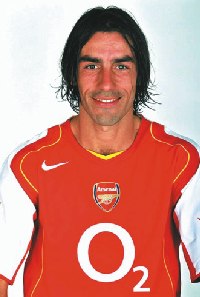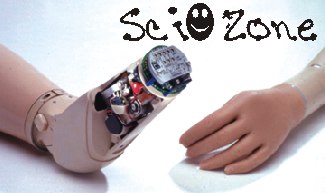
 By Quazi Zulquarnain Islam
By Quazi Zulquarnain Islam
Comfortable in any midfield position, Robert Pires often likes to push wide on either the right or the left from where he can deliver a telling cross or cut in and create a goal-scoring chance for himself. His brilliant feet, great acceleration and cool finishing prove an irresistible combination. All in all Robert Pires is a complete modern midfield player whose supporters appreciate his clever passing and ability to cut inside and score crucial goals.
History:
National team
The 2002 FIFA World Cup was robbed of one of Europe's in-form players after the mercurial Frenchman's wonderful season was cruelly cut short when he injured knee ligaments in an FA Cup game. A World Cup winner on home soil in 1998, Pires created David Trezeguet's golden goal, which won UEFA EURO 2000™
for Les Bleus. Injury limited his UEFA EURO 2004™ qualifying appearances to three, but in Portugal he played in all four games of France's run to the quarter-finals, although by his standards the tournament was a huge letdown.
Club
Pires was a graduate of the FC Metz youth academy, making his senior debut in 1992. During six seasons at the Saint-Symphorien stadium, he scored over 40 goals, prompting a €7.5m move to Olympique de Marseille.
1998: Pires was often brilliant for Marseille but his second season was far from memorable, as his form dipped and he lost the captaincy, prompting a €9.8m switch to England in the summer of 2000.
2000: The fee initially proved a burden to Pires but Arsenal fans soon warmed to his skills. He admitted that he found the Premiership more difficult than the French League.
2001/02: He was Arsenal's outstanding performer as they won both the Premiership and FA Cup in - a watershed campaign for the player. Pires added vital goals (19) to his many assists (13) as the team built up an irresistible post-Christmas charge, his displays earning him the Football Writers' Player of the Year award. After recovering from his cruciate ligament injury, Pires's season ended on a high when he scored the only goal as Arsenal defeated Southampton FC in the 2003 FA Cup final.
2003/04: A key member of the Arsenal side that made history by winning the championship without losing a game, Pires came close to emulating his stunning form of two years ago. Fourteen league goals - coupled with four in Europe - helped lift the goal scoring burden from Thierry Henry.
2004/05: A dip in form for Pires has seen Arsenal relinquish their Premiership crown without much of a fight. Although he has scored into the double figures this season as well, his influence has been far less than previous years, especially with the arrivals of Van Persie and Jose Reyes.
Did you know?
o Pires was offered race driving lessons by former Formula 1 star Jean Alesi.
o Pires was voted in the EPL Overseas Team ozf the Decade.
 The entire robotic society hung their metals in shame as Panna Felsen, a wee seventeen-year-old girl, defeated three robots in the first ever man-versus-machine arm-wrestling contest. The fact(s) that Panna is artfully anorexic and watching Power Puff Girls was just about the only professional training she had ever had, only made the pain worse.
The entire robotic society hung their metals in shame as Panna Felsen, a wee seventeen-year-old girl, defeated three robots in the first ever man-versus-machine arm-wrestling contest. The fact(s) that Panna is artfully anorexic and watching Power Puff Girls was just about the only professional training she had ever had, only made the pain worse.
The purpose of the contest, however, was not to prioritize the sole-savior of planet earth, just in case the Terminator spoof ends up coming true; it's just that the Jet Propulsion Laboratories in NASA wanted to encourage the development of polymer-based artificial muscles, hence the bizarre contest. The ultimate aim, they said, is to have an artificial arm beat the strongest person in earth. But, for the time being, they wanted to make the challenge slightly more attainable for the wee robots, which is why Panna Felsen, a high school student from San Diego, US, was chosen to represent humanity. Apparently, even she proved to be too macho!
Polymer-based artificial muscles, by the way, are used in prosthetics and robots. An average electronic prosthetic available in the market nowadays uses electronic motors, which tend to be too weak and can hardly be used for any kind of heavy work. However, the actuators (i.e. artificial muscles) in the three robot-arms that took part in the arm-wrestling contest, belonged to a certain class of materials known as the electroactive polymers (EAP). These are plastics, which can change shape when activated either electrically or with chemicals. Scientists believe that with the help of EAP someday the prosthetics will work as good as the real limbs.
Panna was not to be fooled by all that sweet talk, though. She defeated the first robot in a matter of 24 seconds. Then she had some pep talk from an arm-wrestling expert, and went on to beat the rest in just four and three seconds! Two arm-wrestling experts oversaw the matches to ensure that standard arm-wrestling rules were observed. The three robot teams went haywire as soon as the matches were over, and started trying to figure out what went wrong. As it turned out, each robotic arm had three sets of chemically activated muscles acting on the shoulder joint, triggered by hydrochloric acid, which would cause the EAP strand to contract. Apparently, the heartless EAP started contracting just about a couple of minutes after the match was over. Poor losers!
The urge to develop EAP artificial muscles is not deterred by this setback, though. Scientists are hoping to come up with bigger breaks in future. Who knows, we might even end up having another arm-wrestling contest?
Let us hope they'd pick a toddler to represent humanity this time. The toddler wouldn't even know that he's in an arm-wrestling contest, hence the EAP robot might have a remote chance of winning.
(Your suggestions are always welcome at [email protected])
By Tawsif
